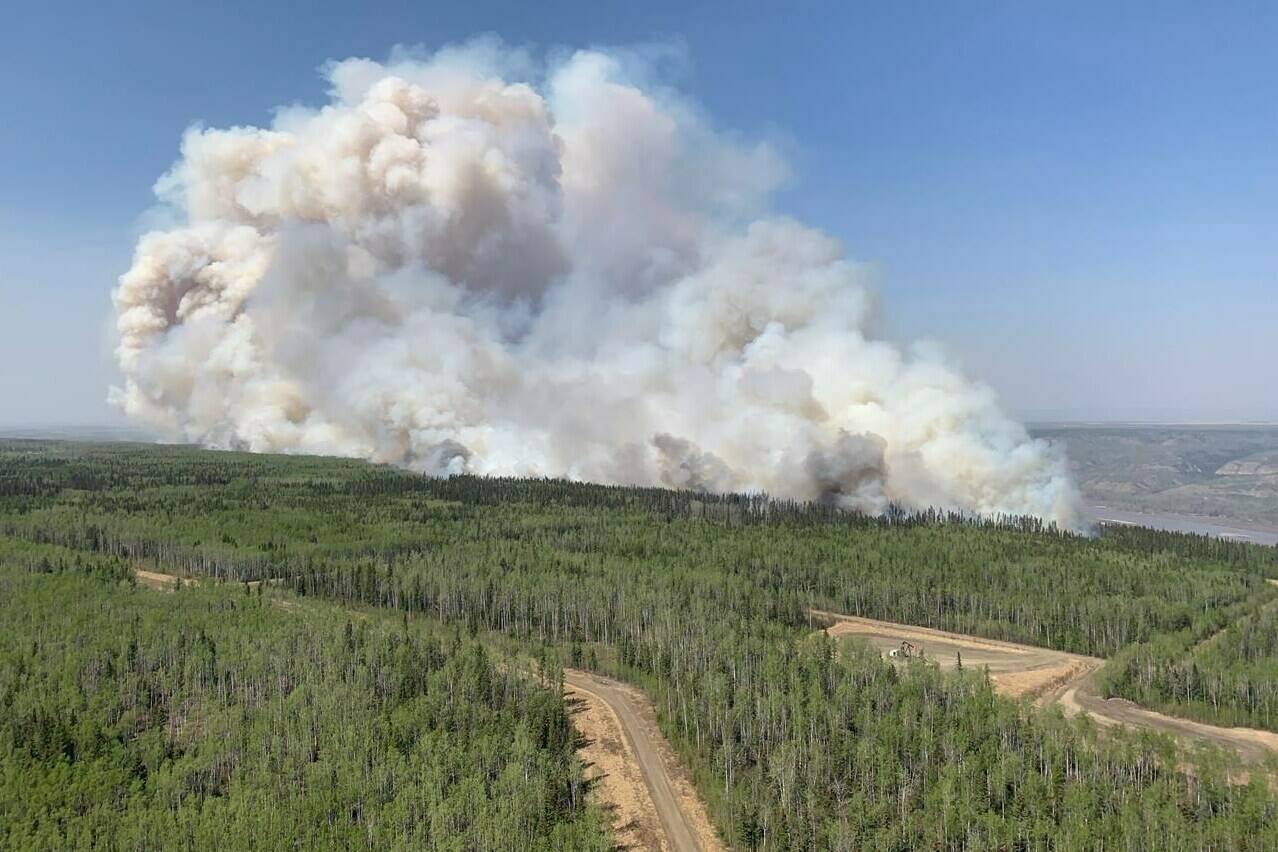Cooler temperatures and a bit of rain were delivering some relief for firefighters as they continued to battle wildfires threatening communities in central northern Alberta, but provincial officials warned the reprieve was only in some areas and lightning was sparking some new blazes.
“People have called this season certainly unprecedented in recent memory because we have so many fires so spread out,” Christie Tucker with Alberta Wildfire told a media briefing Sunday.
“It’s been an unusual year.”
The province said that as of Sunday afternoon there were 108 active fires and the number of evacuees had grown to about 29,000, up from approximately 24,000 the day before.
Tucker said 31 of the fires were classified as out-of-control and, while weather conditions were improving somewhat in southern and central areas, including some showers as far north as Fox Creek, areas further north weren’t as lucky.
A provincewide state of emergency was declared Saturday. Premier Danielle Smith was scheduled to have a phone call with Prime Minister Justin Trudeau on Monday to discuss possible help from the federal government.
“Thankfully, there’s some rain today, but to have stuff happen this early, it’s going to make for a very long summer,” said Chantelle Lalonde of the Darwell Agricultural Society near Evansburg, which has been taking in animals from landowners in the vicinity who’ve been forced to evacuate.
Tucker explained that scattered showers in some areas made it safer for firefighters to get closer to the flames.
“When we see that lifting in conditions — a little bit of humidity, a little bit of coolness — it means that our firefighters can actually get a little bit closer to areas of the fire they had not been able to get into before,” Tucker said.
“The thing that really puts out the flames is boots on the ground.”
Higher temperatures were forecast to return to most areas in a couple of days, however.
The situation has been frustrating for evacuees.
Keith Lenz said he packed his truck with everything he owned and drove out of Drayton Valley with his wife and dog Friday morning.
The town, about 150 kilometres southwest of Edmonton, was asked to evacuate Thursday night, affecting 7,000 residents as the wildfires burned nearby.
The couple arrived in Edmonton on Sunday morning, after they ran out of money while staying at a hotel in Athabasca for two nights.
Sitting outside an evacuation facility set up at the Edmonton Expo Centre, Lenz said he doesn’t know if he has a home to go back to.
“None of us know if our property has been burned,” he said.
“The most stressful part is not knowing where the fire has burned, what’s left, where it is now or how much damage has been in those areas.”
Drayton Valley Coun. Monika Sherriffs, who was also an evacuee at the Expo Centre, said the town has been working on updates but the situation has been overwhelming.
“It’s a tough situation.”
Alberta Emergency Management Agency executive director Colin Blair said accurate damage reports were not available because conditions made it difficult to get them, and he said the focus now is on people’s safety.
There have, however, been reports of buildings being destroyed, including 20 homes, a police station and a store in Fox Lake in northern Alberta.
Electric transmission company AltaLink posted on Twitter late Saturday that “the incredible work of firefighters” slowed fire growth that was threatening infrastructure that supplies power to areas west of Edson, including Hinton, Robb and Jasper, and that cooler weather was expected to help, too.
Edson had already been evacuated and many of its residents were in Hinton and Jasper, with the Municipality of Jasper warning on the weekend there was a possibility the community might lose power.
Earlier Sunday, the premier met with NDP Leader Rachel Notley, which Smith said was intended to keep the Opposition leader informed about the fires and the state of emergency.
Alberta is in the middle of an election campaign with a vote on May 29, and some candidates in areas affected by the fires announced they were suspending campaign activities.
“At times like these, Albertans expect all their elected leaders to work together to help our people,” Smith tweeted after the meeting.
The City of Calgary tweeted that it’s expecting to open a reception centre for evacuees on Monday.
Alberta Health Services, the province’s health delivery agency, said it had evacuated several health-care sites in response to evacuation orders and that it is contacting families of loved ones to share patient and resident location information.
—Rob Drinkwater and Ritika Dubey, The Canadian Press
READ MORE: Out-of-control wildfires in northeastern B.C. expected to worsen due to strong winds
READ MORE: Alberta declares state of emergency due to fires, more than 24,000 out of homes

